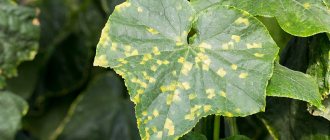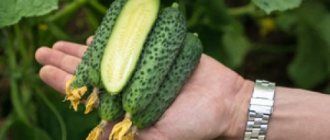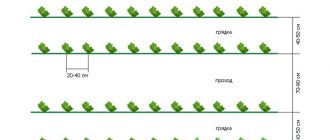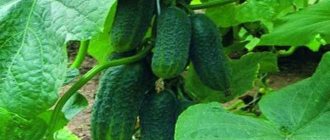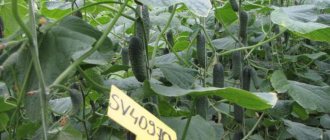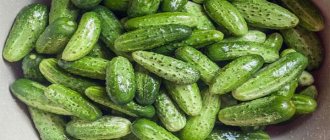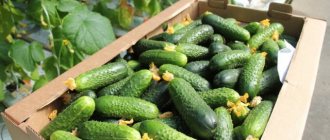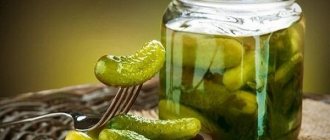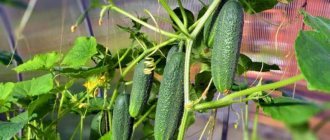Vegetable growing » Cucumbers
0
1516
Article rating
Kira Stoletova
Fusarium wilt of cucumbers is one of the most destructive and aggressive diseases that actively affects large areas of cultivated plants. Just 20 years ago, Fusarium disease attacked mainly grain crops; other types of garden crops were less likely to suffer from this. The trend is changing rapidly. Fusarium also does not spare cucumbers. Resistant to almost all fungicides. Therefore, it is very important to know the symptoms and causes of Fusarium wilt of cucumbers, how to deal with it, what will help preserve the plants, how to prevent infections, what to do if symptoms of the disease are found on the bushes.
Fusarium wilt
Fusarium - what is it?
The causative agent of the disease is the imperfect fusarium fungus. The parasite remains viable for 4 years after entering the soil. Most often, cucumbers become infected through the root system. The pathogen can enter the soil along with affected seed material, wind, and water. After toxins penetrate into the vessels, metabolism is disrupted and the xylem is clogged. This is evidenced by necrosis in various parts of the plant.
In the initial stages, it is quite difficult to identify fusarium. There are no characteristic symptoms during this period.
The fungus progresses if the plant is weakened, the air humidity is at least 85%, and the temperature varies from +18 °C to +27 °C. Cucumbers require special attention during flowering and fruiting.
Vegetables grown in greenhouse conditions most often suffer from fusarium.
Biological features of fusarium and verticillium
For the causative agent of verticillium, high soil temperatures (more than +26 degrees), as well as the absence of moisture, are favorable. At the same time, fusarium is favored by low temperatures and waterlogged soil.
Both of these diseases prefer soil that is highly acidic. Plants affected by this disease exhibit the following types of disorders: vascular blockage, toxicosis, wilting, tissue necrosis.
Fungi can penetrate plants both immediately after sowing and after the seeds germinate. When the root system is injured, a kind of gate is formed for infection to penetrate through it.
Fungi form colonies in the vascular system, and then gradually reach the parenchyma. If the soil containing even a small colony of conidia is not disinfected, it will be practically unsuitable for growing cucumbers.
But the presence of a pathogen does not always lead to drying out and death of the plant. With properly organized care, the number of infected bushes is reduced by about 3 times. Conversely, incorrectly carried out agrotechnical measures significantly increase this indicator.
Causes of fusarium
The infection, once on a personal plot, can be activated under the influence of the following factors:
- sudden changes in temperature;
- lack of soil nutrition;
- increased air humidity;
- abundant watering;
- unsuitable soil (heavy mechanical composition, high acidity, waterlogging);
- damage to the root system;
- pest invasion;
- abuse of nitrogen fertilizers;
- non-compliance with crop rotation and fertilizer application schedule;
- lack of heating (when growing vegetables in a greenhouse).
When growing any crop, the gardener must be guided by agrotechnical requirements.
For example, the soil must be disinfected before planting cucumbers. Failure to do this procedure will significantly increase the risk of Fusarium infection.
How to deal with the problem of fusarium
When growing cucumbers, vegetable growers use special agrotechnical techniques to cope with fusarium blight on cucumbers and prevent the spread of the disease:
- The use of preventive measures to disinfect the soil in the beds using chemicals or heat treatment.
- Purchasing or preparing substrates for planting seeds, taking into account their terms of use.
- To ensure the length of the growing season of cucumbers, at the time of their active fruiting, additional soil is poured out to ensure the formation of an additional root system. Compost is used for this purpose, and is sometimes rolled for optimal aeration.
- Irrigation using the drip method requires drainage so that moisture does not form stagnation.
The formation of plants and regular harvesting reduces the load on the plants, as a result of which the aging process of the plant’s root system slows down.
Biological agents used
Treatment of fusarium wilt of cucumbers is carried out using certain strains of Trichoderma. Such drugs are created in laboratories. You can treat the finished product by adding it to moist soil 2-3 days before planting vegetables. Subsequently, such a suspension is sprayed on the stems, foliage and soil in the beds.
Symptoms of fusarium on cucumbers
The disease can occur secretly and rapidly.
In the first case, the first signs of fusarium are found only on adult plants during flowering and fruiting. It is at this time that cucumbers are most weakened. In addition to leaves, stems and root systems, inflorescences and fruits are affected. The stem begins to rot 7-10 days after the appearance of chloroticity.
The rapid germination of the fungus entails rapid withering and drying of the affected plants, the disease spreads from bottom to top. The foliage noticeably fades, the root collar acquires a brown tint, and the stem cracks. With high air humidity, a pink coating may appear on it.
If plants are infected during planting, seed germination will noticeably decrease. In the current situation, the gardener is unlikely to wait for the cucumber harvest. The seedlings that have managed to sprout will rot and die.
The main signs of the disease include:
- root thinning;
- darkening of the lower part of the stem;
- the formation of yellow spots on the leaves;
- wilting and deformation of foliage;
- twisting and slow growth of the peduncle;
- death of ovaries;
- complete absence of fruits.
Cucumbers that have had time to form have a bitter aftertaste. In the absence of regular prevention and treatment, the plant will die.
Measures to protect against fusarium and wilt
Pathogenic microorganisms are very resistant and measures to protect against them are not always successful. The best preventive measures are sowing healthy seeds. If, after removing the dead plant, another one is planted, then disinfection of the soil in the hole should be provided, otherwise the newly planted plant will also die.
See also
How to feed cucumbers if there is not enough nitrogen fertilizersRead
Preventive measures
To prevent Fusarium infection, the gardener should:
- disinfect seeds before planting through gradual warming. This method is highly effective, although it takes quite a lot of time. The temperature is gradually increased: the first day - no higher than +35°C, the second - +55 °C, on the third day - +70 °C. To save time, seeds can be treated with Inshur Profi;
- steam the prepared soil. The procedure is not complicated. The bed is watered with boiling water and covered with film for 24 hours. Three sessions are required. After the end of the latter, Trichodermin must be added to the soil cover. The biological product can be replaced with analogues;
- after harvesting the cucumbers, clear the area of all residues (tops, debris, roots), disinfect the soil (150 g of bleach should be used per 1 m2). A good alternative to this method would be to replace the top layer of soil. The inventory will also have to be processed.
It is not recommended to replant weakened plants.
In order for cucumbers to produce a good harvest, they need to create favorable conditions for growth. The air temperature should vary between +20...+26 °C, relative humidity cannot be more than 85%. You also need:
- carefully select seed material;
- sow green manure, for example, white mustard, next to cucumbers;
- comply with the schedule of agrotechnical activities;
- water the beds only with warm, settled water (preferably in the morning);
- spray the soil and plants with biofungicides and growth stimulants;
- feed regularly.
Cucumbers cannot be planted in the same place for several years in a row.
Prevention of disease occurrence
To ensure that the seedling never gets sick with fusarium, it is necessary to prevent the occurrence of the disease.
Proper care and timely processing
The main preventive measure that will protect cucumber seedlings from withering is proper care.
When caring for vegetables, the following procedures are performed:
- Watering. Water the cucumbers regularly, at least three times a week. During summer drought, the bushes are watered every day. The soil is moistened in the late evening, after sunset.
- Feeding. Plants that are regularly fed with nutritional components are much less likely to suffer from fusarium. Cucumbers are fed 3-4 times per season. In this case, they use superphosphate, mullein, bird droppings and potassium sulfate.
- Loosening. After each watering, the soil near the bushes is weeded and loosened. This helps the soil better absorb moisture and allow oxygen to pass through.
We choose varieties resistant to fusarium and verticillium
Experienced vegetable growers recommend planting cucumbers that are resistant to wilting. Resistant cucumber varieties include:
- Rowanushka. A tall vegetable that is resistant to fungal pathologies and frost. You can grow Rowanushka both outdoors and in a greenhouse.
- Dunyasha. A productive variety with juicy and sweetish fruits. Dunyasha's immune system reliably protects her from powdery mildew, fusarium and mosaic.
- Sir. A plant with compact bushes that do not need staking. Sudar does not suffer from fusarium and is not attacked by insects.
Treatment of fusarium in cucumbers
If it is still not possible to avoid Fusarium infection, treatment should be started immediately. The earlier treatment is started, the higher its effectiveness.
Biological products for the treatment of fusarium
The most effective include Trichofit, Trichodermin, Glyokladin, Baktofit, Fitosporin-M, Vitaros. They contain components that can destroy the pathogen and stop the disease. The solution is prepared following the instructions for use (it is included with the medication).
Biological preparations are absolutely safe for both plants and humans. Most often they are used for preventive purposes. If the disease is severely advanced, they will not be able to neutralize the pathogen.
It should be noted that combining chemical and biological agents is not recommended.
Chemicals
They differ from biological ones in their more powerful therapeutic effect. Among gardeners, preparations containing benzimidazole or its derivatives are especially popular.
The list of medications is quite extensive, it includes Fundazol, Arbotrin, Fundazim, Agrotsit and Benomyl. Each of them is accompanied by instructions that indicate the norms and procedure for diluting the solution. At least 10 days must pass between treatments.
Traditional methods
You can combat the symptoms of fusarium through unconventional methods. By using them, the gardener will avoid crop loss, save money and protect cucumbers from chemical exposure. It should be noted that they are most effective in the initial stages of a fungal disease. To achieve the desired effect, you need to strictly follow the chosen recipe.
| Name | Ingredients | Mode of application |
| Milk-iodine solution |
| Treatment of stems. |
| Onion peel infusion |
| Watering, spraying the entire plant. |
| Garlic mixture |
| Processing of the ground part. |
| Wood ash infusion |
| Spraying foliage, stems, vegetables. |
| Whey solution |
| Spraying bushes, watering the soil. |
How dangerous is the disease for cucumbers?
Infection with fungal pathogens most often occurs through the soil. Fusarium affects the vessels inside the shoots, which leads to slower growth. The younger the plant, the more damage it causes to them.
Did you know? The Slavs used lye as soap - wood ash steamed in boiling water.
With timely treatment, the problem can be eliminated, but, unfortunately, it becomes noticeable not at the seedling stage, but when the plants enter the flowering phase. The main danger is that infected specimens begin to wither and die en masse at the fruiting stage.
Infected specimens have reduced immunity, as a result of which they become more susceptible to other infections and bacteria. In this state, cucumbers are often affected by bacterial wilt.
This disease occurs in plants with reduced immunity and cannot be treated. In addition, weakened cucumbers are more often attacked by pests. As a result of such difficulties, losses can amount to up to 70%.
Resistant varieties of cucumbers
Each variety of cucumber has its own characteristics. Gardeners should choose seed based on climatic conditions, soil properties, and resistance to infectious diseases, in particular fusarium. The best varieties in the latter category are considered to be:
- Rowanushka;
- Vocals;
- Zhukovsky;
- Hector;
- Raphael;
- Noble;
- Christina.
Despite the increased immunity of resistant varieties, we must not forget about prevention when growing them.
Fusarium wilt of cucumber is an insidious disease, the symptoms of which can appear suddenly. The better the gardener is prepared, the fewer plants will suffer. Their condition directly depends on compliance with agricultural technology and proper care.
Characteristic signs of infection
On young plantings, the characteristic symptoms of Fusarium wilt are difficult to detect. Signs of the disease can be seen on an adult plant. These include:
- signs of root and basal rot appear on the seedlings (the lower part of the crop darkens, the root becomes thinner);
- wilting of the lower leaves, yellow spots gradually appear on all leaf blades;
- deformation of the leaves - the edges turn yellow, dry out, curl;
- cucumber peduncle slows growth and curls;
- the ovary turns yellow and then dies;
- fruiting is reduced or absent altogether;
- In a diseased crop, cucumbers with a bitter aftertaste are formed.
If treatment is not started, the disease progresses and spreads to all parts of the plant. Complete withering of a culture leads to its death. If the seeds have already been infected, then the sprouted sprouts will experience rotting and a decrease in the germination rate.
Wilting or tracheomycosis of cucumbers
In a greenhouse, you can often observe wilting of cucumber plants; it can be caused for many reasons, but more often the disease is the result of damage to the plant’s vascular system by the fungi Fusarium oxysporum
or
Verticillium spp.
The symptoms of the diseases caused by these pathogens are similar, but there are some differences.
Sometimes cucumber wilting can occur as a result of underdeveloped roots, for example, if the plants are planted in very dense soil, and at a certain period a moment comes when the root system cannot cope with the needs of the plant - it does not provide it with the necessary amount of nutrients and water. When examining these wilting plants, no signs of damage by soil microorganisms were found; only an underdeveloped root system was noticeable.
Planting a cucumber in a recently steamed substrate may damage the plant with non-pathogenic root rot. Thermophilic bacteria and fungi that develop in the steamed substrate can cause temporary toxicosis.
When examining plants, phytopathological analyzes of plants that have withered after planting in the ground show that the cause of the pathology is the partial death of hairs on the roots growing into the ground. This process may last for 1 month.
On wilted plants, as a result of physiological disorders, immunity decreases, and the plants become more susceptible to any infection.
When the soil is enriched with live cultures of beneficial bacteria and fungi contained in the preparations Baktofit, Planriz, Trichodermin, Integral, Fitosporin-M and Pseudobacterin-2, accelerated detoxification of the substrate occurs. A similar phenomenon is observed when high-quality compost is added to the soil, the microbiota of which quickly restores the fungistatic properties of the substrate.
Also, the cause of cucumber wilting may be the penetration of the fungus Verticillium albo-atrum
. Damage by this pathogen can occur on soils with low moisture capacity as a result of improper preparation of beds.
On narrow and high ridges with sloping edges, irrigation water, almost without stopping, rolls into the furrow and becomes practically inaccessible to the plant. And at an elevated soil temperature of 28°C, the root system weakens and the fungus living in the soil penetrates the plant. When leaves, especially the lower tier, are affected, marginal spotting is formed, the tissue between the veins dies, turgor is lost on the leaves of the upper tier and they become chlorotic. Under a microscope, a mycelium is clearly visible on a cross section of the stem of an affected plant.
What is fusarium wilt of cucumbers and how to treat it
Fusarium wilt of cucumbers is one of the most destructive and aggressive diseases that actively affects large areas of cultivated plants. Just 20 years ago, Fusarium disease attacked mainly grain crops; other types of garden crops were less likely to suffer from this. The trend is changing rapidly. Fusarium also does not spare cucumbers. Resistant to almost all fungicides. Therefore, it is very important to know the symptoms and causes of Fusarium wilt of cucumbers, how to deal with it, what will help preserve the plants, how to prevent infections, what to do if symptoms of the disease are found on the bushes.
Powdery mildew of cucumber
Its causative agents are Sphaerotheca fuliginea Erysiphe cichoracearum. Plants are affected starting from the stairs. Cotyledon leaves and leaves and petioles of adult plants are first covered with a thin white or pink-gray coating, which represents conidial sporulation of pathogens. The plaque is predominantly located on the upper side, first in separate spots, later - continuous. Numerous small, black dots form on the plaque - marsupial sporulation - cleistothecia, which are not often observed in open ground. Diseased leaves turn yellow, become deformed, and die. Sometimes stems and fruits become covered with bloom.
In a greenhouse, the infection is introduced mainly from open ground in the fall (with autumn-winter cucumber crops) or early summer (with spring-summer crops), and also persists on plant debris.
The development of the disease is made possible by sharp fluctuations in humidity and air temperature, drafts, lack of light and the optimal temperature for the pathogen +16 ... +20 º C, and withering of plants. More often, pockets of powdery mildew begin at doors, transoms, and heating pipes.
Varieties resistant to fusarium
If cases of pathogen activity were recorded on the site last season, then next year it is better to choose fusarium-resistant seeds for sowing. The following hybrid varieties of cucumbers have increased immunity to the disease:
- Rowanushka;
- Dunyasha;
- Raphael;
- Vocals;
- Knight;
- Sir;
- Zhukovsky;
- Obsky;
- Caprice;
- Hector;
- Bunny, etc.
Attention!
Growing cucumbers from resistant varieties does not provide a 100% guarantee that fusarium will not appear. It is advisable to carry out prevention.
There are many methods to combat fusarium wilt of cucumbers. Timely use of protective agents will help preserve the quality and quantity of the crop. To prevent the fungus from appearing on the site, and the disease does not affect the vegetable crop, it is important to follow the rules of prevention. Strong, healthy bushes are able to resist the “invasion” of fungal pathology.
Agronomists have long learned to breed plants that are resistant to various diseases. Therefore, there are a considerable number of cucumber varieties that are not afraid of Fusarium wilt. These are mainly hybrids labeled F1. If you doubt that you can protect your plantings from fusarium, it is better to choose one of them.
The most popular varieties:
- Dvoryansky is a mid-early hybrid that requires insect pollination and is resistant to fusarium, anthracnose, bacteriosis, cladospora blight, ascochyta blight and viral infections.
- Vocal is a high-yielding hybrid, resistant to fungal infections and unfavorable conditions: high humidity, temperature changes, lack of sunlight.
- Obsky is a hybrid with tasty and juicy fruits, resistant to fusarium, downy mildew, bacteriosis and temperature changes.
- Ideal and Vityaz are mid-early parthenocarpic hybrids.
- Zaychik, Zhukovsky, Hector and Alex are early ripening parthenocarpic hybrids.
- Sudar, Dolomite and Christina are early ripening bee-pollinated hybrids.
In addition to these varieties, cucumbers Ryabinushka, Dunyasha and Kapriz show resistance to fusarium. The manufacturer indicates the characteristic features of the variety in the description on the seed package, where you can also find information about the diseases to which they show resistance.
However, prevention should be carried out even when growing disease-resistant varieties. Be extremely attentive to cucumber bushes and other plantings in your greenhouse or on your plot - and you will get a healthy, tasty and high-quality harvest.
